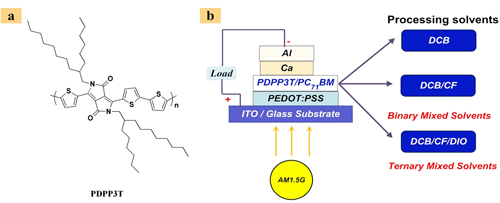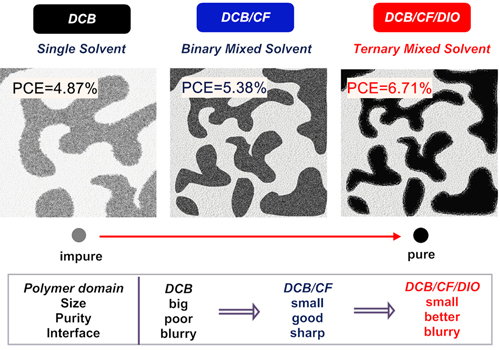Morphology in Polymer Solar Cells Tuned by Ternary Mixed Solvent
Polymer Solar Cells (PSCs) have great potential to serve as light weight, flexible and low-cost power sources. Binary solvent mixtures play a very important role in high performance PSCs in recent years. Crystallinity, as well as domain size in the D/A blends can be tuned effectively by using binary solvent mixtures, while for detailed parameters,such as domain purity and interface roughness,this method is less effective.
Recently, Prof. HOU Jianhui’s group from the State Key Laboratory of Polymer Physics and Chemistry, the Institute of Chemistry, the Chinese Academy of Sciences(ICCAS) made great progress on the morphology fine-tuning by using ternary solvent in polymer solar cells. By incorporating three functional solvents as processing solvent for the fi rst time, they successfully created efficient BHJ PSC devices with PDPP3T: PC71BM as active layer (Figure 1).
The evolution of the morphology from the pure solvent (DCB) to the binary mixed solvent (DCB/CF) and then to ternary mixed solvent (DCB/CF/DIO) is well demonstrated by utilizing RSoXS and GIWAXS techniques. The advantage of ternary mixed solvents treatment is the combination of two steps tuning of morphology, and hence long-range ordered structure with favorable domain size and good domain purity as well as the rougher domain interfaces in the PDPP3T: PC71BM blend can be realized (See Figure 2).
This work demonstrates the first successful example for the application of ternary solvent mixture in PSC device fabrication. More importantly, this method could pave a path to the optimization of other high performance photovoltaic materials.
Under the supports of the National Natural Science Foundation of China, the Chinese Ministry of Science and Technology, the Chinese Academy of Sciences, the results have been published in Advanced Materials (Adv. Mater. 2012, 24, 6335−6341)(http://onlinelibrary.wiley.com/doi/10.1002/adma.201202855/pdf), and commented by Science Daily entitled with “How Solvent Mixtures Affect Organic Solar Cells Structure” (http://www.sciencedaily.com/releases/2012/10/121004163028.htm )。

Figure 1. (a) Molecular structures of PDPP3T and (b) device structure diagram. (Image by YE Long)

Figure 2. Morphology evolution of the PDPP3T/PC71BM blends prepared by different solvents. (Image by YE Long,Weily Copyright)





